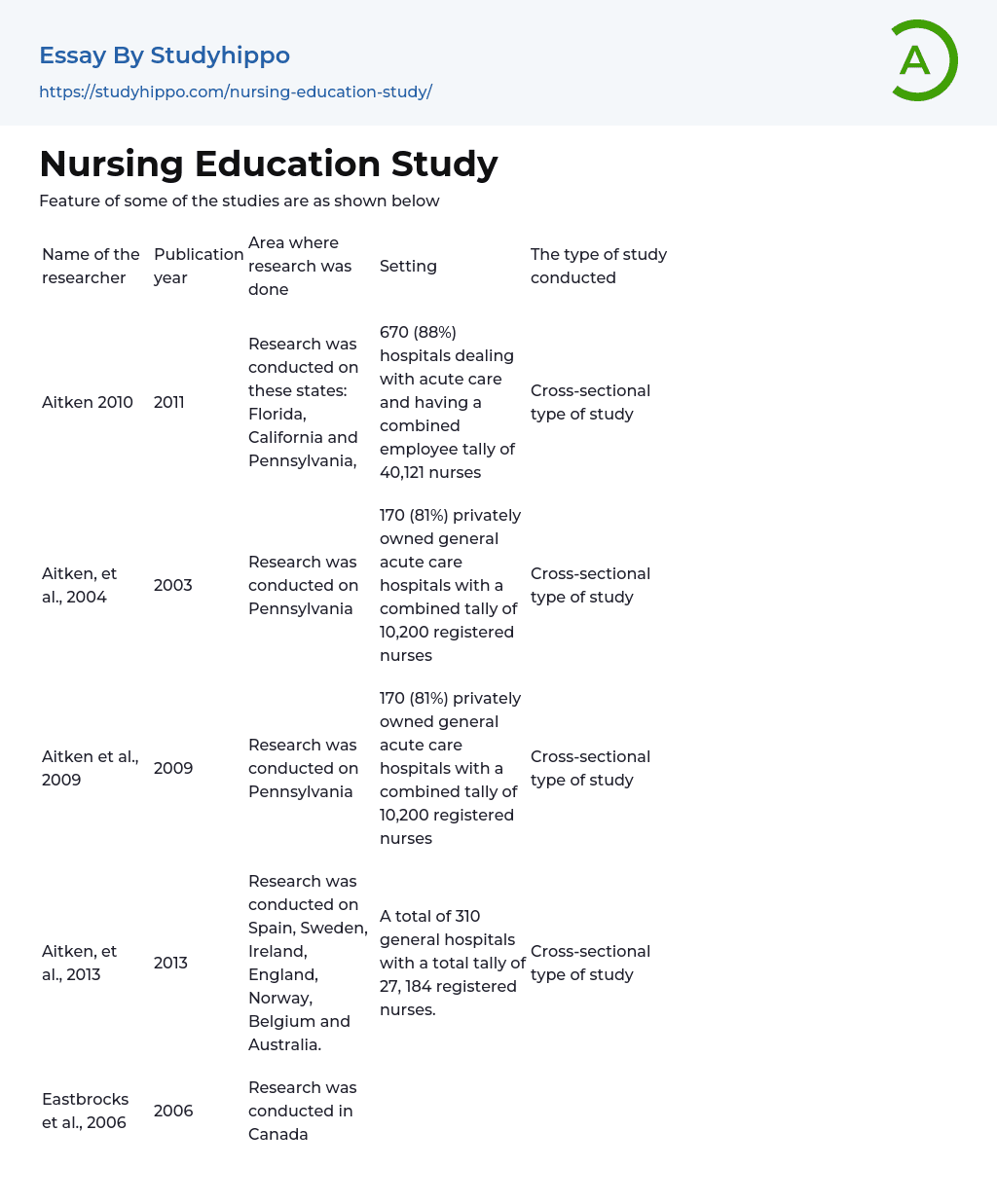Below are the features of some of the studies:
|
Name of the researcher |
Publication year |
-bottom: 1,0000pt solid windowtext; mso-border-bottom-alt: 0,5000pt solid windowtext;" valign="center" width="131"> Area where research was done
|
Setting
| The type of study conducted
View entire sample
Join StudyHippo to see entire essay
|
|
Aitken 2010 |
2011 |
Research was conducted on these states: Florida, California and Pennsylvania, |
670 (88%) hospitals dealing with acute care |
Cross-sectional type of study |
|
Aitken, et |
2003 |
Research was conducted on Pennsylvania |
1,0000pt solid windowtext; mso-border-bottom-alt: 0,5000pt solid windowtext;" valign="center" width="151">
170 (81%) privately owned general acute care hospitals with a combined tally of |
Cross-sectional type of study |
|
Aitken et al., |
2009 |
Research was conducted on Pennsylvania |
170 (81%) privately owned general acute care hospitals with a combined tally of |
Cross-sectional type of study |
|
Aitken, et |
2013 |
Research was conducted on Spain, Sweden, Ireland, England, Norway, Belgium and Australia. |
A total of 310 general hospitals with a total tally of 27, 184 registered nurses. |
Cross-sectional type of study |
|
Eastbrocks |
0,0000pt 5,4000pt 0,0000pt 5,4000pt; border-left: none; ;mso-border-left-alt: none; ;border-right: 1,0000pt solid windowtext; mso-border-right-alt: 0,5000pt solid windowtext; border-top: none; ;mso-border-top-alt: 0,5000pt solid windowtext; border-bottom: 1,0000pt solid windowtext; mso-border-bottom-alt: 0,5000pt solid windowtext;" valign="center" width="81"> 2006 |
Research was conducted in Canada |
50 acute care hospitals analyzed with a total tally of 6,615 registered nurses. |
Cross-sectional type of study |
|
Gullugher K. |
2010 |
Research was conducted in the following states: Florida, California and New Jersey) |
711 (82%) acute |
Secondary analysis and assessment of past studies |
|
Carney-L |
2009 |
Research was conducted in California |
160 acute care hospitals with 10,112 staff nurses directly involved in |
padding: 0,0000pt 5,4000pt 0,0000pt 5,4000pt; border-left: none; ;mso-border-left-alt: none; ;border-right: 1,0000pt solid windowtext; mso-border-right-alt: 0,5000pt solid windowtext; border-top: none; ;mso-border-top-alt: 0,5000pt solid windowtext; border-bottom: 1,0000pt solid windowtext; mso-border-bottom-alt: 0,5000pt solid windowtext;" valign="center" width="159"> Cross-sectional type of study |
|
Carney-L |
2012 |
Research was conducted in California |
width="151">
140 acute care hospitals |
Two-stage |
|
Walton |
2008 |
windowtext;" valign="center" width="131"> Research was conducted in Canada |
A total of 80 community hospitals with a total of 3,994 nurses all plying their trade in medical-surgical hospitals. |
Cross-sectional type of study |
Education for nursing
Research on school interventions
Investigation of educational measures
The study interventions consisted of nurses who had obtained their Bachelor of Science in Nursing degrees. Most of these intervention studies collected data through a nurse questionnaire survey (Aiken et al., 2011; Aiken et al., 2014; Eastbrocks et al., 2006; Kendall-Gallagher et al., 2011;; Kutney-Lee & Aiken, 2008; Tourangeau et al., 2007).
Several studies used nurse surveys and administrative data to assess and confirm the total number of nurses with a Bachelor of Science in nursing in their specific hospice settings (Aitken, et al., 2013; Aitken, et al., 2004; Carney-L & Aiken, 2013).
The nurse questionnaire survey had an average response rate of 51%, with the range typically falling between 35% and 65%. However, there were significant differences among nurses with BSN degrees, varying across hospitals with some reporting as low as 0% and others as high as 100%.
Education requirements for registered nursing
Features
of the intervention
|
Name of the researcher |
The method use |
The response rate of the nurses interviewed |
Percentage average of Bachelor of Science in nursing |
|
Aitken 2010 |
The number of patients discharged compared to the nurse’s level of education |
40% |
Thirty-percent of the hospitals have fewer |
|
;mso-border-top-alt: 0,5000pt solid windowtext; border-bottom: 1,0000pt solid windowtext; mso-border-bottom-alt: 0,5000pt solid windowtext;" valign="center" width="85">
Aiken, et |
The number of patients discharged compared to the nurse’s level of education and the administrative information on the nurses. |
53% |
The percentage of staff nurses with holders of a Bachelor of Science in Nurse, whereas in eleven percent of hospitals |
|
Aiken et al., |
The number of patients discharged compared to the nurse’s level of education and the administr Popular Essay Topics
Get an explanation on any task
Get unstuck with the help of our AI assistant in seconds
New
 Haven't found what you were looking for?
Enter your email to get the sample
By clicking Send Me The Sample you agree to our Terms and Conditions. We won’t send you irrelevant messages or spam.
Thanks! The sample has been sent.
Check your Inbox or join StudyHippo now to benefit from thousands of ideas
Join StudyHippo now

Unfortunately copying the content is not possibleTell us your email address and we’ll send this sample there.By continuing, you agree to our Terms and Conditions. |


